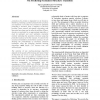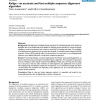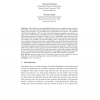294 search results - page 35 / 59 » Predicting the beta-helix fold from protein sequence data |
BMCBI
2010
13 years 2 months ago
2010
Background: A new paradigm of biological investigation takes advantage of technologies that produce large high throughput datasets, including genome sequences, interactions of pro...
BMCBI
2005
13 years 7 months ago
2005
Background: This paper addresses the problem of recognising DNA cis-regulatory modules which are located far from genes. Experimental procedures for this are slow and costly, and ...
IJBRA
2007
13 years 7 months ago
2007
A function of a protein is dependent on its structure; therefore, predicting a protein structure from an amino acid sequence is an active area of research. Optimally predicting a ...
BMCBI
2005
13 years 7 months ago
2005
Background: The alignment of multiple protein sequences is a fundamental step in the analysis of biological data. It has traditionally been applied to analyzing protein families f...
JUCS
2006
13 years 7 months ago
2006
: The need for processing biological information is rapidly growing, owing to the masses of new information in digital form being produced at this time. Old methodologies for proce...



